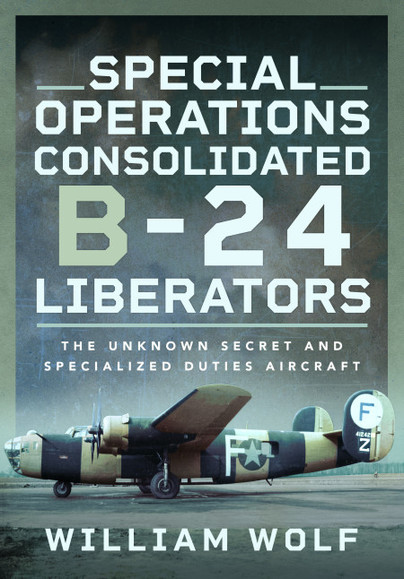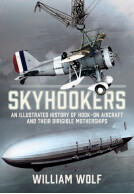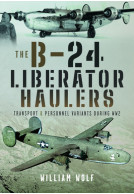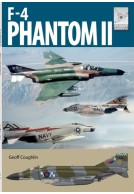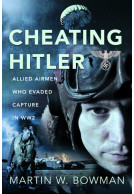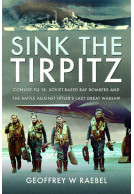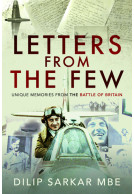Special Operations Consolidated B-24 Liberators (eBook)
The Unknown Secret and Specialized Duties Aircraft
Imprint: Air World
File Size: 21.1 MB (.epub)
Pages: 256
ISBN: 9781399057783
Published: 28th November 2023
| Other formats available - Buy the Hardback and get the eBook for £1.99! | Price |
|---|---|
| Special Operations Consolidated… Hardback Add to Basket | £25.00 |
Despite being America’s most produced bomber, the Consolidated B-24 Liberator has forever flown in the shadow of its more famous and glamorous B-17 rival. The workmanlike B-24 performed multiple unheralded roles in all theatres beyond its also multiple offensive missions, making it the war’s most versatile heavy bomber. Besides its offensive bombing, anti-submarine, and mining missions, the Liberator performed many little known “inoffensive” duties.
Undoubtedly the most colourful of all Liberators were the so-called assembly ships of the Groups of the 2nd Air Division. Their unique paint schemes of stripes, polka dots, and checkerboard, were designed to make them ultra-conspicuous for their task of acting as leaders on which a Group formation could assemble their combat formations more quickly for a combat mission
The Consolidated F-7 was a photographic reconnaissance version of the B-24 Liberator. The F-7 saw service in most theatres of the war. The long range of the Liberator also made it well suited to mapping missions during the war and post-war.
Beginning in early 1944, to aid the Allied liberation of Europe, Carpetbagger B-24s were utilized to parachute spies, called “Joes” or “Janes”, or provide aerial supply of weapons and other matériel to resistance fighters in occupied Europe. Liberators also participated in the dropping of 2.75 billion propaganda leaflets using various techniques and delivery devices.
Electronic Warfare played an important part in Allied global pre-invasion plans to discover the location of enemy radars, and, if possible, destroy them. This interception and analysis of an enemy electronic radiation was the origin of present day ELINT (ELectonicINTelligence). Modified RAF B-24D Airborne Electronic Reconnaissance Liberators, codenamed Ferret, were Radio Counter Measures and Electronic Intelligence aircraft that played a major role in European air opera¬tions.
During 1942 the AAF became interested in aerial refueling as a means to bombing Japan. A shorter-range B-17E was selected as the receiver aircraft while the more spacious B-24D acted as the tanker. Although these tests were considered to be successful, the availability of longer-ranging B-29s and bases ever closer to Japan diminished the urgency of wartime aerial refueling.
During the war, eighty-three B-24s crashed or made forced landings in Switzerland, sixty in Sweden, and several in Russia, Spain, Portugal, and Turkey. Many of these Liberators landed undamaged or were repaired to be flown by these nations. Of particular interest are the six Liberators that were captured and flown by the Luftwaffe.
Packed with a unique collection of photographs. Special Operations Consolidated B-24 Liberators reveals the most unusual and little-known facets of the Second World War’s most versatile bomber.
William Wolf’s Special Operations Consolidated B-24 Liberators is a deeply rewarding resource, packed with rare detail and inspiration for diorama and model builds. The book meticulously explores the myriad roles of the B-24 beyond its typical bombing missions, including its adaptations as assembly ships, photo reconnaissance aircraft, leaflet bombers, electronic warfare platforms, and more. The text is not only technically informative but is also visually rich, featuring dozens of historical photos that showcase some of the most unusual and colorful liveries ever applied to Liberators, from checkerboards and polka dots to shark-mouth motifs and improvised tail identifiers.
Vintage Airfix
Read the full review here
“For anyone interested in the B–24 and some of its more unusual applications, details that most books gloss over, and in some interesting tales of little-known aspects of the air war, this is certainly a book to read—and read closely.”
The Journal of the Air Force Historical Foundation - Spring 2025
As featured in
Air Fan - February - March 2025, No496
About William Wolf
Dr WILLIAM WOLF was a dentist for twenty-two years before retiring at the age of 45 to pursue his aviation interests and outdoor pastimes. Over the past forty-five years he has amassed an archive of over 27,000 books and magazines, 10,000 or more images, and hundreds of reels of microfilm, among other material, on the subject. He is the author of twenty-four books on aerial warfare in the Second World War, including nine on American bombers, two on US fighters, five on American flying units, and three volumes on US aerial armament.







